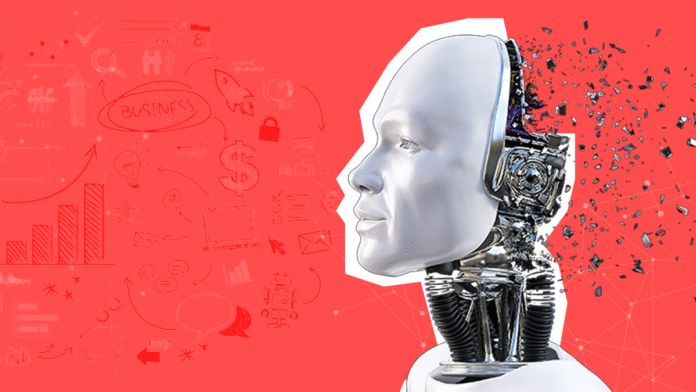This new bubble underscores the extremely parasitic nature of capitalism and the need for a socialist alternative.
Marcus Kollbrunner, Liberdade, Socialismo e Revolução (ISA in Brazil)
(This article was first published on 6 October 2025)
Stock markets in the US are reaching record levels led by the ‘Magnificent Seven’ tech giants, with hundreds of billions being invested in new energy and water-hungry datacenters, and trillions more in the pipeline. At the same time however, voices are being raised warning of an AI bubble that could burst at any time. Those warnings don’t come from fringe figures, but from key players like Mark Zuckerberg from Meta (Facebook, Instagram, Whatsapp), Sam Altman (OpenAI), and Joe Tsai (Alibaba). Even Xi Jinping has raised warnings of overinvestment in China.
A chief economist at investment giant Apollo says the bubble is already bigger than the dot-com bubble, with the top ten AI stocks more detached from reality than the tech titans of the 1990s were.
In the short term, investments in datacenters, more and more of which are dedicated to AI, have contributed to keeping the US and world economy afloat, in a very unstable situation with record levels of debt and tariff wars. The bursting of the AI bubble would probably trigger a bigger crisis, like the housing bubble in the US did in the crisis of 2007-09.
The need for critical minerals, water, and enormous amounts of electricity for the rapid growth of data centers is increasing competition between imperialist powers for resources worldwide, and any pretense of environmental concern is thrown overboard.
This new bubble underscores the extremely parasitic nature of capitalism and the need for a socialist alternative.
Even bigger investments planned
According to data from the Bureau of Economic Analysis, two-thirds of growth in the US (1.6%) during the first half of this year is linked to investment in AI. Without that, the economy would be close to a standstill.
“It may not be an exaggeration to write that NVIDIA—the key supplier of capital goods for the AI investment cycle—is currently carrying the weight of U.S. economic growth. The bad news is that in order for the tech cycle to continue contributing to GDP growth, capital investment needs to remain parabolic. This is highly unlikely,” says George Saravelos of Deutsche Bank.
Google, Meta, Microsoft, and Amazon are on track to spend nearly $400 billion on data centers this year alone. For the next few years, the expectations from the market are astronomical.
A Morgan Stanley report says that AI wants to invest 3 trillion dollars in the next 3 years. Data from McKinsey projects that between 2025 and 2030, companies worldwide will need to invest a remarkable $6.7 trillion into new data center capacity to keep up with AI demand. Another report, from the consulting firm Bain&Co, says the need for investment is $2 trillion per year until 2030.
OpenAI, the company behind ChatGPT, has, together with Softbank, Oracle, and MGX, launched a giant project called “Stargate,” with plans to invest $500 billion by 2029. The plan is to build 10 datacenters in Texas, and expand into more states and countries, like the United Kingdom, Norway, Japan, and the United Arab Emirates.
The mirage of unlimited growth
The problem is that all these investments are based on an assumption of unrealistic growth in productivity, income, and profit within a few years that will pay for all this, and which up to now has been absent. As one commentator summarized it: “If they keep their promises, by the end of 2025, Meta, Amazon, Microsoft, Google, and Tesla will have spent over $560 billion in capital expenditures on AI in the last two years, all to make around $35 billion.”
The same happened with the dot-com bubble. The value of companies exploded with the expectations of the new technology, but the real impact on the economy, in terms of growth in productivity, was limited. That is not only because of unrealistic expectations in the technology itself, but also the character of capitalism and the era of crisis that we live in, that restrains the capacity to use new technology in a socially useful manner.
No profits in sight
No company that is running AI is making a profit. Actually, they are losing billions. The most successful AI company is OpenAI, with 700 million users, but only a small minority pay for the service. The company lost $5 billion last year and is set to lose another $14-15 billion this year. The high cost of running data centers makes the company lose money even from users who pay subscriptions.
Microsoft is a giant that rakes in tens of billions each quarter, but their income from paying AI subscribers is estimated to be $3 billion this year, compared to the planned investment of $80 billion. The situation is similar for the other giants. Amazon, while having a very lucrative cloud service (AWS), is expected to make only $5 billion on AI this year while spending $105 billion. Google is a bit better, with expected revenue of $7.7 billion from $75 billion spent, while Meta is expected to make $2-3 billion and spend $72 billion (the Meta universe virtual reality has been a spectacular failure).
Risk of credit crunch
This AI frenzy is also limiting the available capital for other investments. According to Statista, 71% of venture capital (VC) in the US went to AI funding. But even so, they have problems finding enough money for their investments. Softbank has problems raising money for the $40 billion loan it promised OpenAI. In its turn, OpenAI committed to invest $19 billion in the Stargate project, but for that, it will need the money from SoftBank. And this is just the beginning of these plans to spend hundreds of millions, if not trillions of dollars!
Who makes money, for the time being
The company that is really making money at the moment is Nvidia, which makes the GPUs that are mostly used to train and run AI in datacenters. Their GPUs, at first used for computer graphics, became popular for crypto coin mining, and the market has recently exploded with AI. Their most expensive GPUs, the G200, cost $60-70,000 each, and a single data center can use tens of thousands of those.
Nvidia has now become the world’s most valuable company, with a market value of $4.5 trillion. But this value is based on the expectation of continued growth, which is already showing signs of slowing down from last year’s breakneck speed.
To keep the market growing, Nvidia is investing in the companies that are buying their GPUs. For example, Nvidia made a deal to invest $100 billion in OpenAI, but that is conditioned on OpenAI building many new datacenters and buying hundreds of billions worth of Nvidia’s GPUs!
Oracle has also turned out to be a winner at the moment, by building the datacenters. This has propelled its founder, Larry Ellison (Trump supporter and candidate to take over TikTok), to second place in the list of richest men in the world (Nvidia’s Jensen Huang has also qualified for the top 10). But the company depends totally on the success of these projects, with a debt-to-equity ratio of 400-500%!
The bubble rests on a few giants
It is worth noting that this whole bubble depends largely on deals made between a few giants, buying equipment, building, and making investments, but generating very little income from outside. Laura Bratton from Yahoo Finance reported in May that Microsoft, Amazon, Meta, and Alphabet make up 41.5% of NVIDIA’s revenue, while Microsoft spends 47% and Meta spends 25% of their respective capital expenditures on Nvidia’s chips.
At the moment, the 10 largest companies in the S&P 500 index, that include the Magnificent Seven, account for 40% of the value of the stock market, which is unprecedented. To summarize, 40% of the market depends on a few companies continuing to buy GPUs from Nvidia.
At the moment the markets are still in the “FOMO” (fear of missing out) mode, so the bubble can still grow for a while. But when it bursts, the process downhill can be quite rapid and drag the rest of the economy.
Et tu, China
In China, we also see a frenetic expansion of data centers that has accelerated after DeepSeek captured the world’s attention with a cheaper model that managed to have comparable results to ChatGPT and others.
“When it comes to projects, there are a few things — artificial intelligence, computing power, and new energy vehicles. Do all provinces in the country have to develop industries in these directions?” Xi told the Central Urban Work Conference, a rarely held high-level Communist party meeting on urban development, according to FT.
The development of homegrown AI is strategic in the tense competition with the US, including for military uses. At the same time, Trump is trying to force China to give up control of TikTok’s successful algorithm to US control.
How AI could kill us
There has been some discussion about the risk of AI turning against humanity and threatening our existence. But a more immediate risk is the accelerated destruction of the environment that the companies behind AI are causing, not AI itself.
The expansion of datacenters requires enormous amounts of resources.
There is a growing competition for critical minerals that are driving forces behind wars in Africa and competition between Western and Chinese companies for mines in Africa, Latin America, and Asia.
The data centers are also huge consumers of water for cooling. According to an investigation by SourceMaterial, Amazon, Microsoft, and Google are operating data centers that use vast amounts of water in some of the world’s driest areas on all continents, and are building many more.
There is also an almost infinite need for electricity, that is reverting even the modest steps towards any resemblance of a green transition. It is telling that the capacity of data centers is measured in Gigawatts, in power consumption, not in data capacity or number of GPUs. According to one estimate, data center electricity consumption is projected to more than double between 2024 and 2030, adding an equivalent of the current electricity demand of Japan!
This is all over the world. In the US, power demand from AI data centers could grow more than thirty-fold by 2035, reaching 123 Gigawatts (GW), up from 4 GW in 2024. The Stargate project alone, if fulfilled, would consume as much energy as Belgium.
In China, datacenter power consumption is expected to more than triple by the end of the decade, according to Goldman Sachs. That’s more than all the electricity generated in Germany last year.
In Europe, the estimated data center expansion amounts to about 170 Gigawatts (GW), which is equivalent to approximately one-third of the region’s current power consumption. In Ireland, datacenters are expected to use 32% of the state’s electricity already in 2026.
Access to cheap energy will be a major bottleneck for the expansion of AI, so all possible sources of energy will be used. Currently, fossil fuels provide nearly 60% of power to data centers globally. In spite of the explosion of solar and wind energy in China, the country is actually expanding its coal energy capacity. At the same time, Microsoft, Google, Amazon, and Meta are investing in nuclear power for their data centers.
The limits of LLMs
The frenzy behind AI has been based on predictions that the Large Language Models (LLMs) behind ChatGPT and others would grow in capacity exponentially and rapidly reach AGI – Artificial General Intelligence, capable of anything and more – and replace workers on a large scale. Ford CEO Jim Farley predicted artificial intelligence will halve the number of white-collar jobs in the US.
To reach that, ever bigger models were needed, fed with all data available on the internet. All of it. More than half of the traffic on the internet now is made by AI bots, reaching out for data to train models. This has correctly raised a lot of questions about the right of private companies to use everyone’s data, including books, academic papers, social media posts, news media publications, YouTube videos, etc., for profit.
This has also led to some questioning between the companies. When DeepSeek managed to make a cheaper model, OpenAI tried to accuse them of using their data, but of course, they themselves had just taken it.
In the beginning, the results were impressive, with chatbots seeming to have meaningful conversations, making decent texts, and being used as search engines on steroids. In some areas, and for some specific uses, AI has given impressive results, from beating world champions in chess or finding new proteins for medicine. But the limits of the LLMs are becoming more evident.
Many are questioning if LLMs could ever reach general intelligence, as they are not built to reason, but to generate text according to probability models. At its core, it functions like the ‘autocomplete’ on your phone, but very advanced. That means that it won’t say “I don’t know that, I don’t have enough data,” it will generate what is calculated to be the most probable, even if it has to invent, or as they say, ‘hallucinate’.
There is also a limit to the data available to train the models. With an increasing part of the content on the internet, especially on some social media, being generated by LLMs, the models are being more and more trained by their own hallucinations.
The announcement of ChatGPT 5 was an eye-opener for many, because the result was not the leap forward expected. At the same time, the hype of the last couple of years has lost momentum.
A MIT Media Lab report found, for example, that 95% of generative AI pilots at companies are failing to deliver a measurable financial return on investment, despite $30-40 billion in enterprise investment. As a consequence, data from the US Census Bureau from the beginning of September shows that AI adoption has been declining among companies with more than 250 employees, stagnating in middle-sized companies, and only continuing to grow in small companies with 1-4 employees.
The LLMs have been popular amongst developers of computer code. But, a study from Model Evaluation & Threat Research (METR), a non-profit research group, shows that AI coding tools made software developers slower, despite expectations to the contrary. AI generates code quickly, but you have to spend a lot of time checking for errors. Some argue that AI is good at simple code and routine tasks, on the level of an intern. But if you replace the interns, you risk ending up without the more experienced workers after a while, who start as interns.
According to a survey from Orgvue, 55% of business leaders who have laid off employees in favor of AI admit they made the wrong decision, citing factors like the loss of institutional knowledge, weakened customer experiences and internal disruption.
The need for socialism
As Marx writes in the Capital, machinery is an agent for saving human labor, but the rule of Capital turns the worker into an appendage of the machine. Instead of liberating, it enslaves the workers, to generate profit for a small elite. It is no different with AI.
As we can see, this process is extremely wasteful, destroys the environment, concentrates even more wealth, and is used to undermine the rights of workers.
We need to build a socialist alternative, that can put this technology, that has huge potential, in public hands, under the control of workers, for the benefit of all, not the profit of a few




